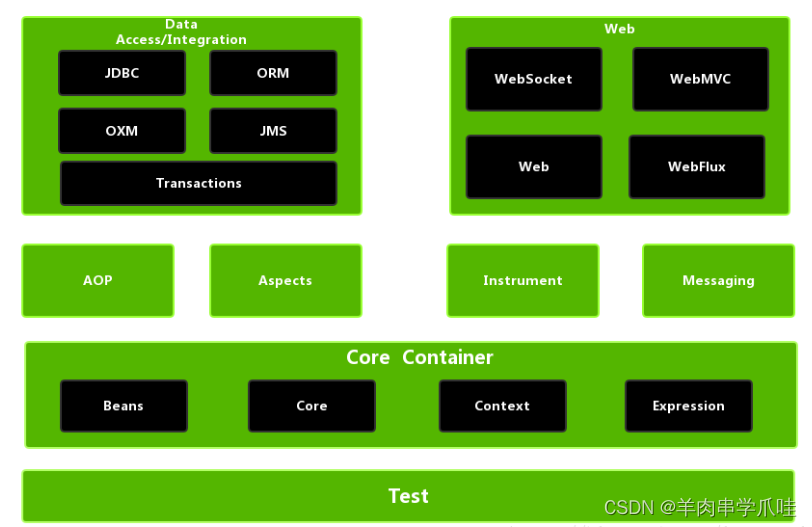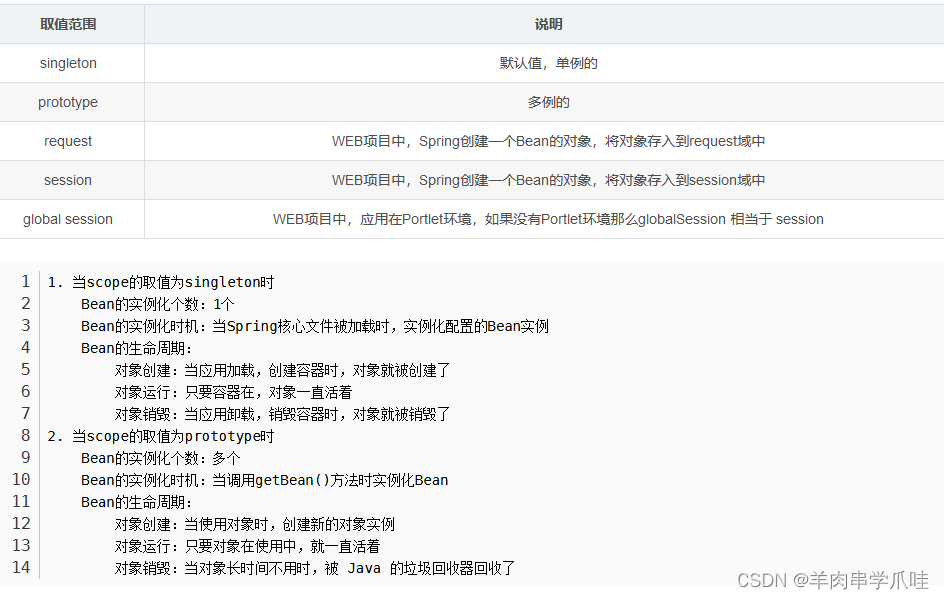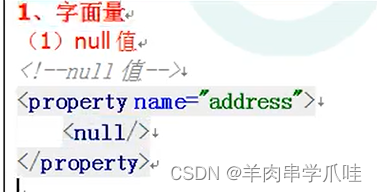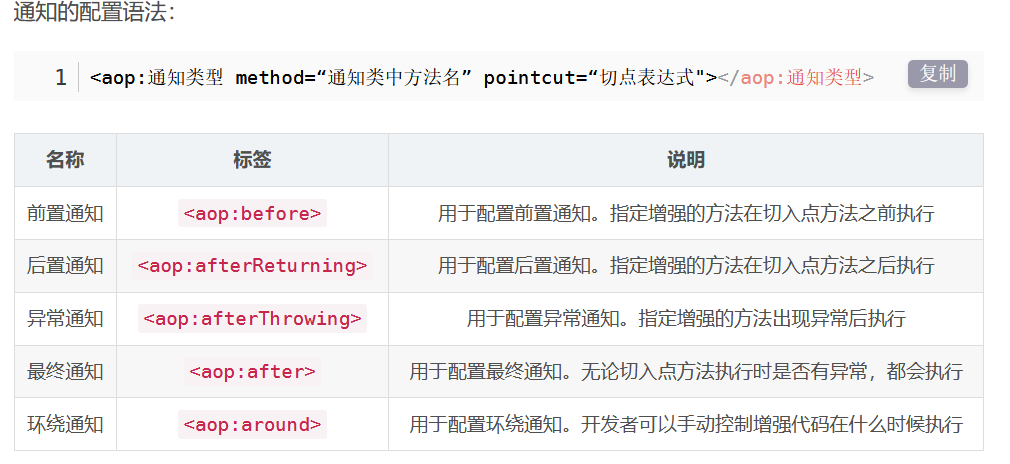目录
4.9 有参构造方法注入(一个是userdao? 另一个时 str?? 配置如下)
测试? 转账中间添加了int i=5/0? 事务捕捉到异常 数据库未发生改变
4 编写通知类 配置核心文件(两种方法 一种是直接写poingtcut? 另一种 是先定义 再用pointcut-ref引入 )
一、Spring简介
1、Spring
Spring是分层的 Java SE/EE应用 full-stack(全栈式) 轻量级开源框架。
提供了表现层 SpringMVC和持久层 Spring JDBC Template以及 业务层 事务管理等众多的企业级应用
技术,还能整合开源世界众多著名的第三方框架和类库,逐渐成为使用最多的Java EE 企业应用开源框
架。
两大核心:以 IOC(Inverse Of Control:控制反转 将创建对象过程交给Spring进行管理)和 AOP(Aspect OrientedProgramming:面向切面编程)为内核。
2.spring优势
1)方便解耦,简化开发
?? ?Spring就是一个容器,可以将所有对象创建和关系维护交给Spring管理
?? ?什么是耦合度?
?? ??? ?对象之间的关系,通常说当一个模块(对象)更改时也需要更改其他模块(对象),这就是耦合,
?? ??? ?耦合度过高会使代码的维护成本增加。要尽量解耦
2)AOP编程的支持
?? ?Spring提供面向切面编程,方便实现程序进行权限拦截,运行监控等功能。
3)声明式事务的支持
?? ?通过配置完成事务的管理,无需手动编程
4)方便测试,降低JavaEE API的使用
?? ?Spring对Junit4支持,可以使用注解测试
5)方便集成各种优秀框架
?? ?不排除各种优秀的开源框架,内部提供了对各种优秀框架的直接支持
二、IOC
1.概念和原理
反转:指的是对象控制权由原来 由开发者在类中手动控制 反转到 由Spring容器控制
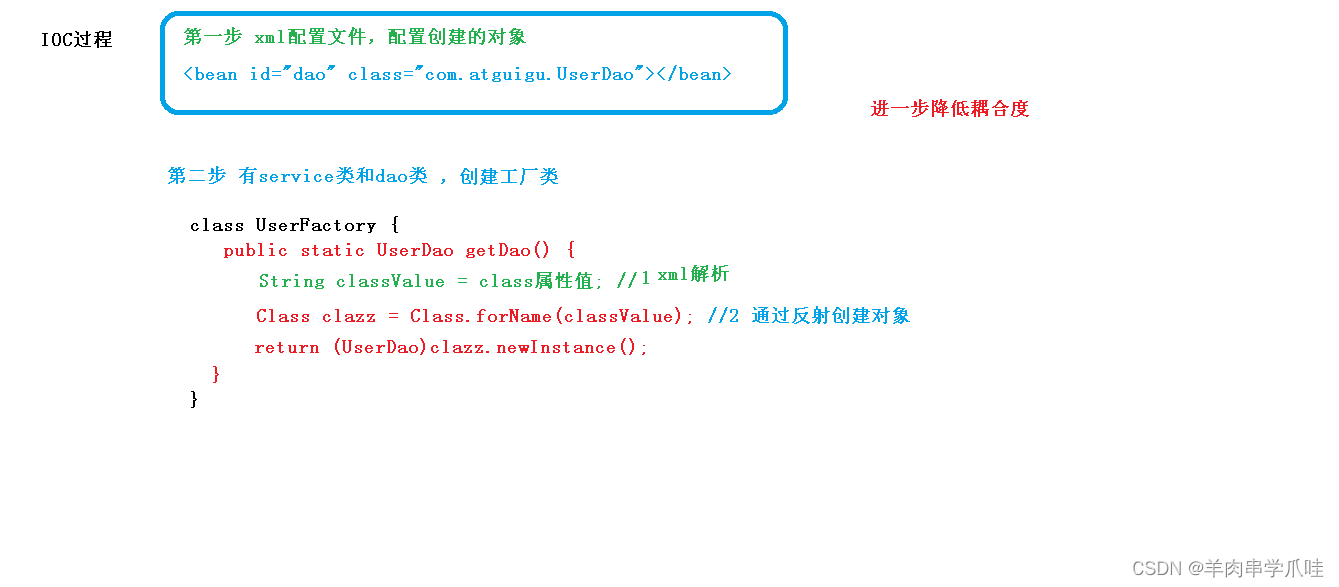
?2.自定义IOC容器
1.需求
1. 创建java项目,导入自定义IOC相关坐标
2. 编写Dao接口和实现类
3. 编写Service接口和实现类
4. 编写测试代码
2.实现
依赖
<dependencies>
<dependency>
<groupId>dom4j</groupId>
<artifactId>dom4j</artifactId>
<version>1.6.1</version>
</dependency>
<dependency>
<groupId>jaxen</groupId>
<artifactId>jaxen</artifactId>
<version>1.1.6</version>
</dependency>
<dependency>
<groupId>junit</groupId>
<artifactId>junit</artifactId>
<version>4.12</version>
</dependency>
</dependencies>
编写Dao接口和实现类
public interface UserDao { public void save(); }public class UserDaoImpl implements UserDao { @Override public void save() { System.out.println("保存成功"); } }
Service接口和实现类
public interface UserService { public void save(); }public class UserServiceImpl implements UserService { private UserDao userDao; public void save() { userDao = (UserDao) BeanFactory.getBean("userDao"); userDao.save(); } }
beans.xml 文件
<beans>
<!-- bean 表示一个需要创建的对象
id: 表示该对象的名字
class:表示该对象的类型
-->
<bean id="userDao" class="com.qiku.dao.UserDaoImpl"></bean>
</beans>
package com.qiku.utils;
/**
* 2022/6/23 15:05
*
* @author yrc
* @version MySpring
*/
import org.dom4j.Document;
import org.dom4j.Element;
import org.dom4j.io.SAXReader;
import java.io.InputStream;
import java.util.HashMap;
import java.util.List;
import java.util.Map;
/**
* 根据配置文件中的信息 创建对象
* 并将所有的对象存入一个容器之中
*/
public class BeanFactory {
//声明一个 map 充当 容器作用 ,用于包存所有的对象
public static Map<String ,Object> ioc=new HashMap<>();
//程序启动时 自动初始化对象
static {
try {
//1 读取配置文件
InputStream resource =
BeanFactory.class.getClassLoader().getResourceAsStream("beans.xml");
//2 解析xml
SAXReader saxReader = new SAXReader();
//2.1 通过saxReader 将resource装换为document
Document document = saxReader.read(resource);
//3 编写xPath表达式
String xPath="//bean";
//4 获取所有的bean标签
List<Element> nodes = document.selectNodes(xPath);
System.out.println(nodes);
//5 遍历 并创建对象 设置到map中
for (Element e:nodes){
String id = e.attributeValue("id");
String className = e.attributeValue("class");
System.out.println("id= "+id);
System.out.println("id= "+className);
Object obj = Class.forName(className).newInstance();
//将 id 和obj存入ioc容器
ioc.put(id,obj);
}
} catch (Exception e) {
e.printStackTrace();
}
}
//提供获取对象的方法
public static Object getBean(String beanId){
return ioc.get(beanId);
}
}
测试类 以及结果

?总结:
* 其实升级后的BeanFactory就是一个简单的Spring的IOC容器所具备的功能。
* 之前我们需要一个userDao实例,需要开发者自己手动创建 new UserDao();
* 现在我们需要一个userdao实例,直接从spring的IOC容器获得,对象的创建权交给了spring控制
* 最终目标:代码解耦合 解耦合并不是没有关系了 只是耦合度降低了
3.Spring相关的API
3.1 图解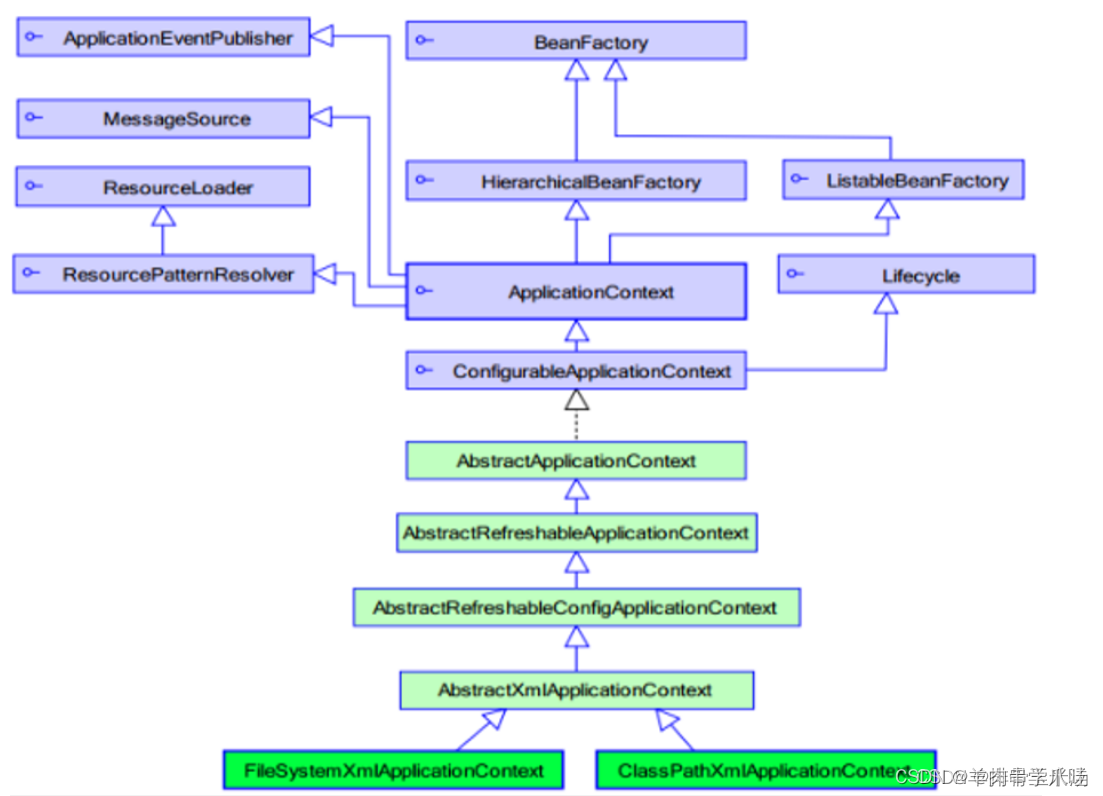
?3.2.BeanFactory 接口
BeanFactory beanFactory = new XmlBeanFactory(new ClassPathResource("applicationContext.xml"));
1. ClassPathXmlApplicationContext
?? ?它是从类的根路径下加载配置文件 推荐使用这种。
2. FileSystemXmlApplicationContext
?? ?它是从磁盘路径上加载配置文件,配置文件可以在磁盘的任意位置。
3. AnnotationConfigApplicationContext
?? ?当使用注解配置容器对象时,需要使用此类来创建 spring 容器。它用来读取注解。
?? ?ApplicationContext app =new ClassPathXmlApplicationContext("applicationContext.xml");
4、Spring相关配置文件和操作
4.1 Bean标签基本配置
<bean id="" class=""></bean>
* 用于配置对象交由Spring来创建。
* 基本属性:
?? ?id:Bean实例在Spring容器中的唯一标识
?? ?class:Bean的全限定名(全路径)name: 不常用
* 默认情况下它调用的是类中的 无参构造函数,如果没有无参构造函数则不能创建成功。
4.2 Bean标签配置范围
<bean id="" class="" scope=""></bean>
4.3 Bean生命周期配置
<bean id="" class="" scope="" init-method="" destroy-method=""></bean>
* init-method:指定类中的初始化方法名称
* destroy-method:指定类中销毁方法名称
4.4 Bean实例化三种方式
??? 无参构造方法实例化
??? 工厂静态方法实例化
??? 工厂普通方法实例化
4.5 无参构造方法实例化
它会根据默认无参构造方法来创建类对象,如果bean中没有默认无参构造函数,将会创建失败
<bean id="userDao" class="com.qiku.dao.impl.UserDaoImpl"/>
4.6 工厂静态方法实例化
应用场景
依赖的jar包中有个A类,A类中有个静态方法m1,m1方法的返回值是一个B对象。如果我们频繁使用B对象,此时我们可以将B对象的创建权交给spring的IOC容器,以后我们在使用B对象时,无需调用A类中的m1方法,直接从IOC容器获得。
public class StaticFactoryBean {
?? ?public static UserDao createUserDao(){
?? ??? ?return new UserDaoImpl();
?? ?}
}
<bean id="userDao" class="com.qiku.factory.StaticFactoryBean" factory-method="createUserDao" />4.7 工厂普通方法实例化
应用场景
依赖的jar包中有个A类,A类中有个普通方法m1,m1方法的返回值是一个B对象。如果我们频繁使用B对象,此时我们可以将B对象的创建权交给spring的IOC容器,以后我们在使用B对象时,无需调用A类中的m1方法,直接从IOC容器获得。
public class DynamicFactoryBean {
?? ?public UserDao createUserDao(){
?? ??? ?return new UserDaoImpl();
?? ?}
}
<bean id="dynamicFactoryBean" class="com.qiku.factory.DynamicFactoryBean"/>
<bean id="userDao" factory-bean="dynamicFactoryBean" factory-method="createUserDao"/>4.8 Bean依赖注入概述
依赖注入 DI(Dependency Injection):它是 Spring 框架核心 IOC 的具体实现。
在编写程序时,通过控制反转,把对象的创建交给了 Spring,但是代码中不可能出现没有依赖的情况。IOC 解耦只是降低他们的依赖关系,但不会消除。例如:业务层仍会调用持久层的方法。
那这种业务层和持久层的依赖关系,在使用 Spring 之后,就让 Spring 来维护了。简单的说,就是通过框架把持久层对象传入业务层,而不用我们自己去获取。
4.9 有参构造方法注入(一个是userdao? 另一个时 str?? 配置如下)
public UserServiceImpl(UserDao userDao,String str) {
System.out.println("有参构造器执行了 ");
this.userDao = userDao;
}<!-- 配置userDao 将其交给Spring 的容器管理–>-->
<bean id="userDao" class="com.qiku.dao.impl.UserDaoImpl"></bean>
<!-- 配置UserService-->
<bean id="userService" class="com.qiku.service.impl.UserServiceImpl">
<!-- (1) 使用有参构造器的 方式注入 index下标0 代表第一个参数
1 则代表 第二个参数 type 为参数类型 ref 为引用数据类型 指的是上面 的 id userDao-->
<!-- <constructor-arg index="0" type="com.qiku.dao.UserDao" ref="userDao"/>-->
<!-- 第(2)种方法 name表示参数中的名字 代表之前的 index=0-->
<constructor-arg name="userDao" type="com.qiku.dao.UserDao" ref="userDao"></constructor-arg>
<constructor-arg name="str" type="java.lang.String" value="123"></constructor-arg>
</bean>4.10 set方法注入
public void setUserDao(UserDao userDao) {
System.out.println("set方法执行了");
this.userDao = userDao;
}配置spring容器利用set方法注入
<bean id="userDao" class="com.qiku.dao.impl.UserDaoImpl"></bean>
<bean id="userService2" class="com.qiku.service.impl.UserServiceImpl">
<property name="userDao" ref="userDao"/>
</bean>4.11 命名空间注入
xmlns:p="http://www.springframework.org/schema/p" <!-- p命名空间 注入-->
<bean id="userDao" class="com.qiku.dao.impl.UserDaoImpl"></bean>
<bean id="userService3" class="com.qiku.service.impl.UserServiceImpl"
p:userDao-ref="userDao">
</bean>4.12 set 普通数据类型的注入
public class User {
private String username;
private String age;
public void setUsername(String username) {
this.username = username;
}
public void setAge(String age) {
this.age = age;
}
}
<bean id="user4" class="com.qiku.pojo.User">
<constructor-arg name="name" value="马孟德"></constructor-arg>
<constructor-arg name="age" value="35"></constructor-arg>
<!-- <property name="name" value="马孟德"></property>-->
<!-- <property name="age" value="35"></property>-->
</bean>4.13 集合 数组 map properties 的注入
User类? 还有set 方法
private List<Object> list;
private Object[] arrays;
private Map<String,Integer> map;
private Properties properties;配置文件
<!-- 注入集合类型-->
<bean id="user5" class="com.qiku.pojo.User">
<property name="list" >
<list>
<value>chaolihai</value>
<value>bucuoou</value>
<value>zhadsafds</value>
<ref bean="userDao"></ref>
</list>
</property>
</bean>
<!-- 注入数组类型-->
<bean id="user6" class="com.qiku.pojo.User">
<property name="arrays" >
<array>
<value>chaolihai</value>
<value>bucuoou</value>
<value>zhadsafds</value>
<ref bean="userDao"></ref>
</array>
</property>
</bean>
<!-- 注入map类型-->
<bean id="user7" class="com.qiku.pojo.User">
<property name="map" >
<map>
<entry key="嗨嗨嗨" value="8"></entry>
<entry key="clearlove" value="7"></entry>
<entry key="老阴逼" value="6"></entry>
</map>
</property>
</bean>
<!-- 注入Properties类型数据-->
<bean id="user8" class="com.qiku.pojo.User" scope="prototype">
<property name="properties">
<props>
<prop key="driver">com.mysql.jdbc.Driver</prop>
<prop key="url">jdbc:mysql://localhost:3306/mydb</prop>
<prop key="username">root</prop>
<prop key="password">root</prop>
</props>
</property>
</bean>测试
//集合注入
@Test
public void test10() {
ClassPathXmlApplicationContext context =
new ClassPathXmlApplicationContext("applicationContext.xml");
User user = context.getBean("user5", User.class);
System.out.println(user.getList());
context.close();
}
@Test
public void test11() {
ClassPathXmlApplicationContext context =
new ClassPathXmlApplicationContext("applicationContext.xml");
User user = context.getBean("user6", User.class);
System.out.println(user.getArrays());
context.close();
}
//集合注入
@Test
public void test12() {
ClassPathXmlApplicationContext context =
new ClassPathXmlApplicationContext("applicationContext.xml");
User user = context.getBean("user7", User.class);
System.out.println(user.getMap());
context.close();
}
@Test
public void test13() {
ClassPathXmlApplicationContext context =
new ClassPathXmlApplicationContext("applicationContext.xml");
User user = context.getBean("user8", User.class);
System.out.println(user.getProperties());
context.close();
}4.14? 配置文件模块化
实际开发中,Spring的配置内容非常多,这就导致Spring配置很繁杂且体积很大,所以,可以将部分
配置拆解到其他配置文件中,也就是所谓的配置文件模块化。
1)并列的多个配置文件
ApplicationContext act = new ClassPathXmlApplicationContext("beans1.xml","beans2.xml","...");
2)主从配置文件
<import resource="applicationContext-xxx.xml"/>

4.15 知识小结
<bean>标签:创建对象并放到spring的IOC容器
?? ?id属性:在容器中Bean实例的唯一标识,不允许重复
?? ?class属性:要实例化的Bean的全限定名
?? ?scope属性:Bean的作用范围,常用是Singleton(默认)和prototype<constructor-arg>标签:属性注入
?? ?name属性:属性名称
?? ?value属性:注入的普通属性值
?? ?ref属性:注入的对象引用值<property>标签:属性注入
?? ?name属性:属性名称
?? ?value属性:注入的普通属性值
?? ?ref属性:注入的对象引用值
?? ?<list>
?? ?<set>
?? ?<array>
?? ?<map>
?? ?<props>
?? ?
<import>标签:导入其他的Spring的分文件
属性中包含尖括号
属性设置空值
5 Dbutils整合
5.1 xml的形式
5.1.1 核心配置文件
<?xml version="1.0" encoding="UTF-8"?>
<beans xmlns="http://www.springframework.org/schema/beans"
xmlns:context="http://www.springframework.org/schema/context"
xmlns:xsi="http://www.w3.org/2001/XMLSchema-instance"
xsi:schemaLocation="
http://www.springframework.org/schema/beans
http://www.springframework.org/schema/beans/spring-beans.xsd
http://www.springframework.org/schema/context
http://www.springframework.org/schema/context/spring-context.xsd"
>
<!-- spring 加载外部文件-->
<context:property-placeholder location="classpath:jdbc.properties"/>
<!-- 将数据库连接池交给IOC容器-->
<bean id="dataSource" class="com.alibaba.druid.pool.DruidDataSource">
<property name="driverClassName" value="${jdbc.driver}"></property>
<property name="url" value="${jdbc.url}"></property>
<property name="username" value="${jdbc.username}"></property>
<property name="password" value="${jdbc.password}"></property>
</bean>
<!-- 将QueryRunner 交给IOC 容器-->
<bean id="queryRunner" class="org.apache.commons.dbutils.QueryRunner">
<!--利用有参构造器的方式将 datasource注入 -->
<constructor-arg name="ds" ref="dataSource"></constructor-arg>
</bean>
<!-- 将AccountDao 交给IOC-->
<bean id="accountDao" class="com.qiku.dao.impl.AccountDaoImpl">
<property name="qr" ref="queryRunner"></property>
</bean>
<!--把AccountService交给IOC容器-->
<bean id="accountService" class="com.qiku.service.impl.AccountServiceImpl">
<property name="accountDao" ref="accountDao"></property>
</bean>
</beans>
5.1.2 jdbc配置文件
jdbc.driver=com.mysql.jdbc.Driver
jdbc.url=jdbc:mysql://localhost:3306/spring_db?useUnicode=true&characterEncoding=utf8&useSSL=false
jdbc.username=root
jdbc.password=root5.1.3 set方法
queryrunner在Dao层 set注入spring容器

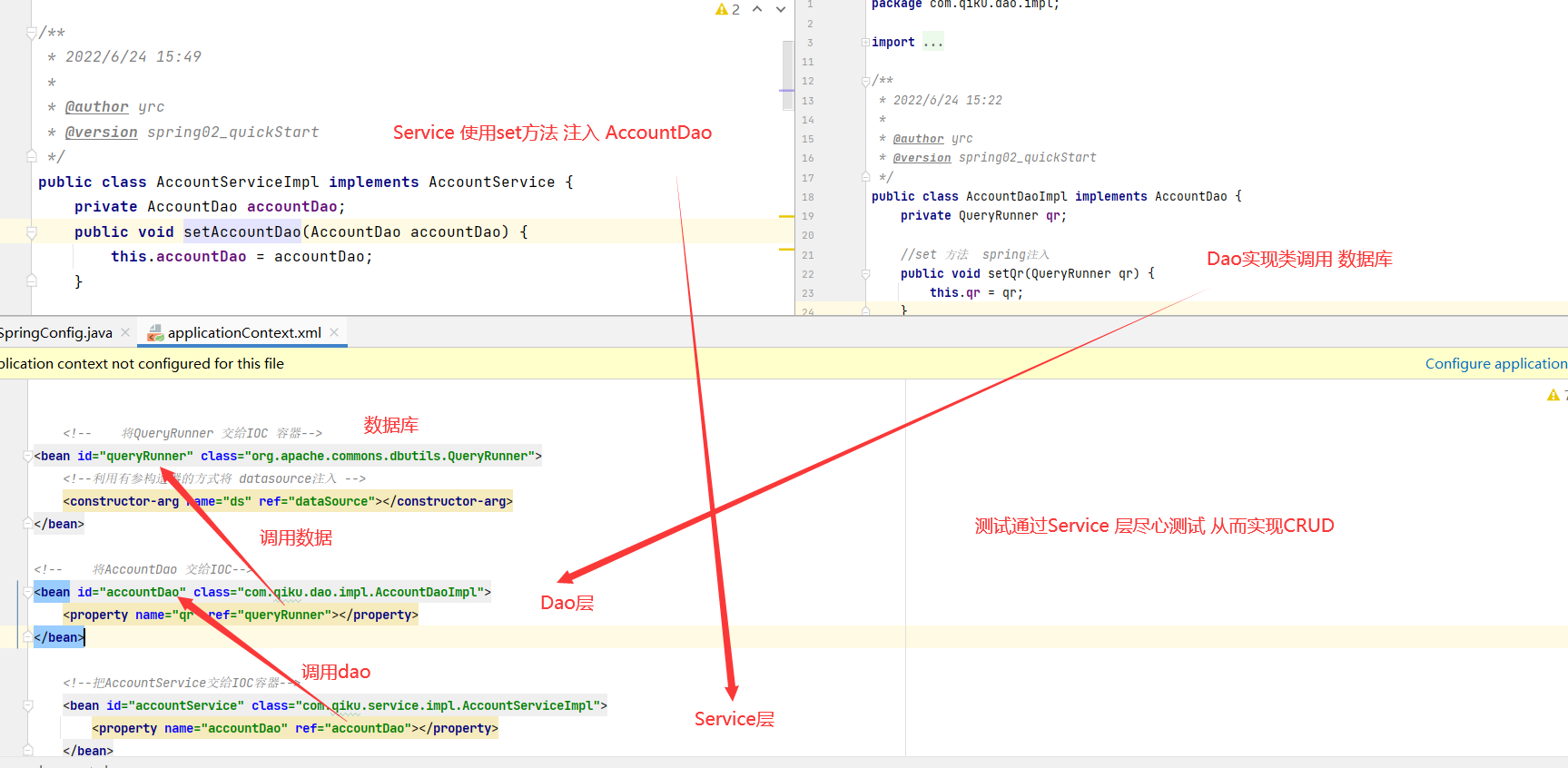
5.2 注解的形式 (无配置文件)
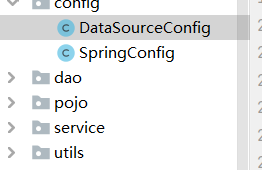
jdbc 配置文件同5.1.2
5.2.1 数据库配置类
package com.qiku.config;
/* 数据源配置
* */
import com.alibaba.druid.pool.DruidDataSource;
import org.springframework.beans.factory.annotation.Value;
import org.springframework.context.annotation.Bean;
import org.springframework.context.annotation.PropertySource;
import javax.sql.DataSource;
@PropertySource("classpath:jdbc.properties")
public class DataSourceConfig {
//使用EL表达式 读取配置文件中的值 给属性赋值
@Value("${jdbc.driver}")
private String driver;
@Value("${jdbc.url}")
private String url;
@Value("${jdbc.username}")
private String username;
@Value("${jdbc.password}")
private String password;
@Bean
public DataSource getDataSource(){
DruidDataSource dataSource = new DruidDataSource();
dataSource.setDriverClassName(driver);
dataSource.setUrl(url);
dataSource.setUsername(username);
dataSource.setPassword(password);
return dataSource;
}
}
5.2.2 Spring 核心配置类
package com.qiku.config;
import org.apache.commons.dbutils.QueryRunner;
import org.springframework.beans.factory.annotation.Autowired;
import org.springframework.context.annotation.Bean;
import org.springframework.context.annotation.ComponentScan;
import org.springframework.context.annotation.Configuration;
import org.springframework.context.annotation.Import;
import javax.sql.DataSource;
/**@Configuration 写在类上面
* 表示该类是一个配置类
* @ComponentScan 用于开启注解扫描
*
* @Import(DataSourceConfig.class)
* 引入其他配置类
*/
@Configuration
@ComponentScan("com.qiku")
@Import(DataSourceConfig.class)
public class SpringConfig {
// @Bean 写在方法上 用于将第三方的类 交给IOC容器
//默认的beanId同样是雷鸣的首字母小写 体现为方法的返回值类型
@Bean("queryRunner")
public QueryRunner getQueryRunner(
@Autowired DataSource dataSource) {
return new QueryRunner(dataSource);
}
}
5.2.3 DAO层实现类
package com.qiku.dao.impl;
import com.qiku.dao.AccountDao;
import com.qiku.pojo.Account;
import org.apache.commons.dbutils.QueryRunner;
import org.apache.commons.dbutils.handlers.BeanHandler;
import org.apache.commons.dbutils.handlers.BeanListHandler;
import org.springframework.beans.factory.annotation.Autowired;
import org.springframework.stereotype.Repository;
import java.sql.SQLException;
import java.util.List;
/**
* 2022/6/24 15:22
*
* @author yrc
* @version spring02_quickStart
*/
@Repository
public class AccountDaoImpl implements AccountDao {
@Autowired
private QueryRunner qr;
//set 方法 spring注入
public void setQr(QueryRunner qr) {
this.qr = qr;
}
@Override
public void save(Account account) throws SQLException {
String sql = "insert into account(name,money) " +
"values(?,?)";
int update = qr.update(sql, account.getName(), account.getMoney());
}
@Override
public void update(Account account) throws SQLException {
String sql="update account set name=? ,money=? where id=?";
int update = qr.update(sql, account.getName(), account.getMoney(), account.getId());
}
@Override
public void delete(Integer id) throws SQLException {
String sql="delete from account where id=?";
qr.update(sql,id);
}
@Override
public List<Account> findAll() throws SQLException {
String sql="select * from account";
List<Account> query = qr.query(sql, new BeanListHandler<Account>(Account.class));
return query;
}
@Override
public Account findById(Integer id) throws SQLException {
String sql="select * from account where id =?";
Account query = qr.query(sql, new BeanHandler<Account>(Account.class),id);
return query;
}
}
5.2.4 Service层实现类
package com.qiku.service.impl;
import com.qiku.dao.AccountDao;
import com.qiku.pojo.Account;
import com.qiku.service.AccountService;
import org.springframework.beans.factory.annotation.Autowired;
import org.springframework.stereotype.Service;
import java.sql.SQLException;
import java.util.List;
/**
* 2022/6/24 15:49
*
* @author yrc
* @version spring02_quickStart
*/
@Service
public class AccountServiceImpl implements AccountService {
@Autowired
private AccountDao accountDao;
public void setAccountDao(AccountDao accountDao) {
this.accountDao = accountDao;
}
@Override
public void save(Account account) throws SQLException {
accountDao.save(account);
}
@Override
public void update(Account account) throws SQLException {
accountDao.update(account);
}
@Override
public void delete(Integer id) throws SQLException {
accountDao.delete(id);
}
@Override
public List<Account> findAll() throws SQLException {
List<Account> all = accountDao.findAll();
return all;
}
@Override
public Account findById(Integer id) throws SQLException {
Account account = accountDao.findById(id);
return account;
}
}
5.2.5 测试类
package com.qiku.test;
import com.qiku.config.SpringConfig;
import com.qiku.pojo.Account;
import com.qiku.service.AccountService;
import org.junit.Test;
import org.springframework.context.ApplicationContext;
import org.springframework.context.annotation.AnnotationConfigApplicationContext;
import org.springframework.context.support.ClassPathXmlApplicationContext;
import java.sql.SQLException;
import java.util.List;
/**
* 2022/6/24 16:37
*
* @author yrc
* @version spring02_quickStart
*/
public class AccountServiceTest {
//加载配置类
ApplicationContext context =
new AnnotationConfigApplicationContext(SpringConfig.class);
// 没有配置文件了
// private ClassPathXmlApplicationContext context
// =new ClassPathXmlApplicationContext("applicationContext.xml");
//从IOC中获取accountService对象
private AccountService accountService= context.getBean("accountServiceImpl",AccountService.class);
// 测试报保存信息
@Test
public void testSave() throws SQLException {
Account account=new Account();
account.setName("lucy");
account.setMoney(9999.99);
accountService.save(account);
}
@Test
public void testUpdate() throws SQLException {
Account account=new Account();
account.setId(3);
account.setName("机甲战士");
account.setMoney(9999.99);
accountService.update(account);
}
@Test
public void testFindAll() throws SQLException {
Account account=new Account();
List<Account> all = accountService.findAll();
System.out.println(all);
}
@Test
public void testFindById() throws SQLException {
Account account=new Account();
account.setId(1);
Account byId = accountService.findById(account.getId());
System.out.println(byId);
}
@Test
public void testDelete() throws SQLException {
Account account=new Account();
accountService.delete(4);
}
}
5.2.6 数据库

6 Spring整合Junit? 代码 和5 的一样
6.1 为什么用 Spring测试

6.2 依赖
<!--此处需要注意的是,spring5 及以上版本要求 junit 的版本必须是 4.12 及以上-->
<dependency>
<groupId>org.springframework</groupId>
<artifactId>spring-test</artifactId>
<version>5.1.5.RELEASE</version>
</dependency>
<dependency>
<groupId>junit</groupId>
<artifactId>junit</artifactId>
<version>4.12</version>
<scope>test</scope>
</dependency>
6.3 测试
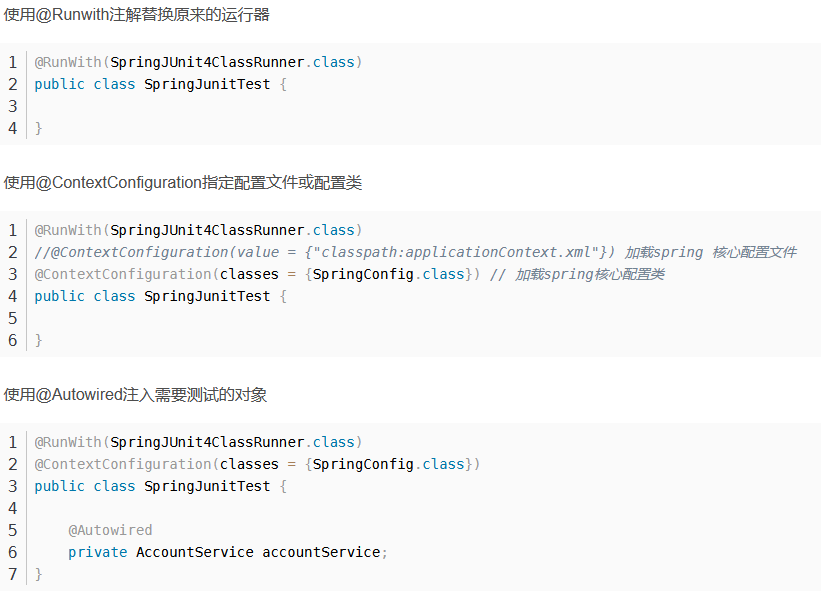
@RunWith(SpringJUnit4ClassRunner.class)
@ContextConfiguration(classes = {SpringConfig.class})
public class SpringAndJunitTest {
@Autowired
private AccountService accountService;
@Test
public void testFindALL() throws SQLException {
List<Account> all = accountService.findAll();
System.out.println(all);
}
@Autowired
private DataSource dataSource;
@Test
public void test02(){
System.out.println(dataSource);
}
}三、AOP
1 AOP概念
(1)面向切面编程(方面),利用 AOP 可以对业务逻辑的各个部分进行隔离,从而使得业务逻辑各部分之间的耦合度降低,提高程序的可重用性,同时提高了开发的效率。(2)通俗描述:不通过修改源代码方式,在主干功能里面添加新功能
2? AOP底层原理(JDK动态代理和CGLIB动态代理)
我们可以将业务代码和事务代码进行拆分,通过动态代理的方式,对业务方法进行事务的增强。这样就不会对业务层产生影响,解决了耦合性的问题啦!
常用的动态代理技术
JDK 代理 : 基于接口的动态代理技术·:利用拦截器(必须实现invocationHandler)加上反射机制生成一个代理接口的匿名类,在调用具体方法前调用InvokeHandler来处理,从而实现方法增强
CGLIB代理:基于父类的动态代理技术:动态生成一个要代理的子类,子类重写要代理的类的所有不是final的方法。在子类中采用方法拦截技术拦截所有的父类方法的调用,顺势织入横切逻辑,对方法进行增强
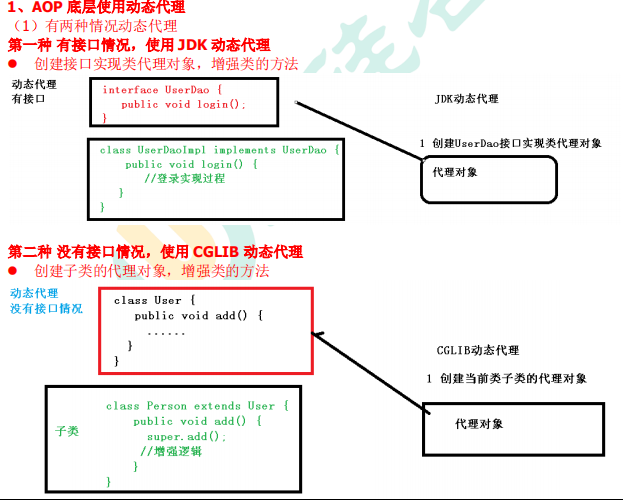
核心配置文件??? jdbc.properties 同上
<?xml version="1.0" encoding="UTF-8"?>
<beans xmlns="http://www.springframework.org/schema/beans"
xmlns:context="http://www.springframework.org/schema/context"
xmlns:xsi="http://www.w3.org/2001/XMLSchema-instance"
xsi:schemaLocation="
http://www.springframework.org/schema/beans
http://www.springframework.org/schema/beans/spring-beans.xsd
http://www.springframework.org/schema/context
http://www.springframework.org/schema/context/spring-context.xsd"
>
<context:component-scan base-package="com.qiku"></context:component-scan>
<!-- spring 加载外部文件-->
<context:property-placeholder location="classpath:jdbc.properties"/>
<!--<!– 将数据库连接池交给IOC容器–>-->
<bean id="dataSource" class="com.alibaba.druid.pool.DruidDataSource">
<property name="driverClassName" value="${jdbc.driver}"></property>
<property name="url" value="${jdbc.url}"></property>
<property name="username" value="${jdbc.username}"></property>
<property name="password" value="${jdbc.password}"></property>
</bean>
<!-- 将QueryRunner 交给IOC 容器-->
<bean id="queryRunner" class="org.apache.commons.dbutils.QueryRunner">
<!--利用有参构造器的方式将 datasource注入 -->
<constructor-arg name="ds" ref="dataSource"></constructor-arg>
</bean>
</beans>
数据库连接工具类 和 事务工具类
package com.qiku.utils;
import org.springframework.beans.factory.annotation.Autowired;
import org.springframework.stereotype.Component;
import javax.sql.DataSource;
import java.sql.Connection;
import java.sql.SQLException;
/**
* 由于之前的 in out 操作都是独立的食物 并且独立的连接
* 解决方法:
* 将获取连接的方式统一管理 以及同一个事务中尽心操作
*
* 链接工具类: 从数据源中获取一个链接 并实现线程的绑定
*
*
*/
@Component
public class ConnectionUtils {
// 创建本地线程 绑定的是数据库连接
private ThreadLocal<Connection> threadLocal=new ThreadLocal<>();
// 从IOC容器中 获取数据源对象
@Autowired
private DataSource dataSource;
//获取当前线程上的连接
public Connection getThreadConnection() {
//1 先从threadlocal里面获取 当前连接
Connection connection = threadLocal.get();
//判断connection 是否为null
if (connection == null) {
try { //则说明是第一次获取 则从数据源中 获取连接 并与线程绑定
connection = dataSource.getConnection();
threadLocal.set(connection);
} catch (SQLException e) {
e.printStackTrace();
}
}
return connection;
}
//解除绑定
public void removeThreadConnection(){
threadLocal.remove();
}
}
事务工具类
package com.qiku.utils;
import org.springframework.beans.factory.annotation.Autowired;
import org.springframework.stereotype.Component;
import java.sql.SQLException;
/*
* 事务管理器 :开启事务 提交事务 回滚事务 释放资源
* */
@Component
public class TransactionManager {
@Autowired
private ConnectionUtils connectionUtils;
//开启事务
public void beginTransaction(){
try {
//开启事务 并关闭自动提交
connectionUtils.getThreadConnection().setAutoCommit(false);
} catch (SQLException e) {
e.printStackTrace();
}
}
public void commit(){
try {
//提交事务
connectionUtils.getThreadConnection().commit();
} catch (SQLException e) {
e.printStackTrace();
}
}
public void rollback(){
try {
//事务回滚
connectionUtils.getThreadConnection().rollback();
} catch (SQLException e) {
e.printStackTrace();
}
}
public void release(){
try {
//改回自动提交
connectionUtils.getThreadConnection().setAutoCommit(true);
//归还连接池
connectionUtils.getThreadConnection().close();
//解除与线程的绑定
connectionUtils.removeThreadConnection();
} catch (SQLException e) {
e.printStackTrace();
}
}
}
?2.1 JDK动态代理
2.1.1 工厂动态代理类
package com.qiku.proxy;
import com.qiku.service.AccountService;
import com.qiku.utils.TransactionManager;
import org.springframework.beans.factory.annotation.Autowired;
import org.springframework.stereotype.Component;
import java.lang.reflect.InvocationHandler;
import java.lang.reflect.Method;
import java.lang.reflect.Proxy;
import java.util.Arrays;
@Component
public class JdkProxyFactory {
/*
* 动态代理类*/
//要代理的目标对象
@Autowired
private AccountService accountService;
//事务管理器
@Autowired
private TransactionManager transactionManager;
//创建AccountService 的代理对象
public AccountService getAccountServiceProxy(){
AccountService accountServiceProxy =null;
accountServiceProxy = (AccountService) Proxy.newProxyInstance(accountService.getClass().getClassLoader(),
accountService.getClass().getInterfaces(),
new InvocationHandler() {
@Override
// 代理对象 拦截到的的方法transfer() 拦截到的方法的参数
public Object invoke(Object proxy, Method method, Object[] args) throws Throwable {
Object result=null;
try{
// 开启事务
transactionManager.beginTransaction();
//执行业务处理
result= method.invoke(accountService,args);
//提交事务
transactionManager.commit();
}catch (Exception e){
e.printStackTrace();
transactionManager.rollback(); //回滚事务
}finally {
transactionManager.release();//释放资源
}
return result;
}
}
);
return accountServiceProxy;
}
}
2.2 CGLIB动态代理
package com.qiku.proxy;
import com.qiku.service.AccountService;
import com.qiku.utils.TransactionManager;
import org.springframework.beans.factory.annotation.Autowired;
import org.springframework.cglib.proxy.Enhancer;
import org.springframework.cglib.proxy.MethodInterceptor;
import org.springframework.cglib.proxy.MethodProxy;
import org.springframework.stereotype.Component;
import java.lang.reflect.InvocationTargetException;
import java.lang.reflect.Method;
import java.util.Arrays;
@Component
public class CGLIBProxyFactory {
@Autowired
private AccountService accountService;
@Autowired
private TransactionManager transactionManager;
public AccountService getAccountServiceProxy(){
AccountService accountServiceProxy =null;
/**
* 参数一 :目标对象的字节码文件
* 参数二 : 动作类 实现增强功能
*
* */
accountServiceProxy= (AccountService) Enhancer.create(AccountService.class,
new MethodInterceptor() {
@Override
public Object intercept(Object o, Method method, Object[] objects, MethodProxy methodProxy) throws Throwable {
Object result=null;
try {
transactionManager.beginTransaction();
result=method.invoke(accountService,objects);
transactionManager.commit();
} catch (Exception e) {
e.printStackTrace();
transactionManager.rollback();
} finally {
transactionManager.release();
}
return result;
}
});
return accountServiceProxy;
}
}
测试? 转账中间添加了int i=5/0? 事务捕捉到异常 数据库未发生改变

service实现层代码
@Service
public class AccountServiceImpl implements AccountService {
@Autowired
private AccountDao accountDao;
@Override
public void transfer(String outName, String innerName, Double money) {
//支出
accountDao.out(outName,money);
int i=5/0;
// 收入
accountDao.in(innerName,money);
}
}dao实现层代码
@Repository //注册到IOC容器
public class AccountDaoImpl implements AccountDao {
//dao层保证同一个链接
@Autowired
private QueryRunner queryRunner;
@Autowired
private ConnectionUtils connectionUtils;
@Override
public void out(String outerName, double money) {
try { String sql ="UPDATE account SET money=money-? WHERE name=?";
queryRunner.update(connectionUtils.getThreadConnection(),sql,money,outerName);
} catch (SQLException e) {
e.printStackTrace();
}
}
@Override
public void in(String innerName, double money) {
try { String sql ="UPDATE account SET money=money+? WHERE name=?";
queryRunner.update(connectionUtils.getThreadConnection(),sql,money,innerName);
} catch (SQLException e) {
e.printStackTrace();
}
}
}3.AOP术语
3.1 Spring 的 AOP 实现底层就是对上面的动态代理的代码进行了封装,封装后我们只需要对需要关注的部分进行代码编写,并通过配置的方式完成指定目标的方法增强。
在正式讲解 AOP 的操作之前,我们必须理解 AOP 的相关术语,常用的术语如下:
* Target(目标对象):代理的目标对象
* Proxy (代理):一个类被 AOP 织入增强后,就产生一个结果代理类
* Joinpoint(连接点):所谓连接点是指那些可以被拦截到的点,也就是可以被增强的方法。在spring中,这些点指的是方法,因为 spring只支持方法类型的连接点
* Pointcut(切入点):所谓切入点是指我们要对哪些 Joinpoint 进行拦截的定义。真正增强的方法(1)切入点表达式作用:知道对哪个类里面的哪个方法进行增强(2)语法结构: execution([权限修饰符] [返回类型] [类全路径] [方法名称]([参数列表]) )?举例 1:对 com.qiku.dao.BookDao 类里面的 add 进行增强execution(*com.qiku.dao.BookDao.add(.. ))举例 2:对 com.qiku.dao.BookDao 类里面的所有的方法进行增强execution( *com.qiku.dao.BookDao.* ( .. ))举例 3:对 com.qiku.dao 包里面所有类,类* Advice(通知/增强):所谓通知是指拦截到 Joinpoint 之后所要做的事情就是通知 分类:前置通知、后置通知、异常通知、最终通知、环绕通知
当前四个通知组合在一起时,执行顺序如下:
@Before -> @After -> @AfterReturning(如果有异常:@AfterThrowing)
* Aspect(切面):是切入点和通知(引介)的结合
* Weaving(织入):是指把增强应用到目标对象来创建新的代理对象的过程。spring采用动态代理织 入,而AspectJ采用编译期织入和类装载期织入
4 编写通知类 配置核心文件(两种方法 一种是直接写poingtcut? 另一种 是先定义 再用pointcut-ref引入 )
<?xml version="1.0" encoding="UTF-8"?>
<beans xmlns="http://www.springframework.org/schema/beans"
xmlns:aop="http://www.springframework.org/schema/aop"
xmlns:xsi="http://www.w3.org/2001/XMLSchema-instance"
xsi:schemaLocation="
http://www.springframework.org/schema/beans
http://www.springframework.org/schema/beans/spring-beans.xsd
http://www.springframework.org/schema/aop
http://www.springframework.org/schema/aop/spring-aop.xsd">
<!-- 将目标对象 交给 IOC容器-->
<bean id="accountService" class="com.qiku.service.impl.AccountServiceImpl"></bean>
<bean id="userService" class="com.qiku.service.impl.UserServiceImpl"></bean>
<!-- 将通知类 交给 IOC容器-->
<bean id="myAdvice" class="com.qiku.advic.MyAdvice"></bean>
<!-- 配置植入关系 以及切面 方法一-->
<aop:config>
<!-- 引入通知类 即切面 myAdvice-->
<aop:aspect ref="myAdvice">
<!-- 配置目标类的transfer 方法执行是 使用前置 通知-->
<!-- pointcut="execution(* com.qiku.service.impl.AccountServiceImpl.*(..))"/>-->
<aop:before method="before"
pointcut="execution(* com.qiku.service..*.*(..))"/>
</aop:aspect>
</aop:config>
<!-- 方法二-->
<aop:config>
<!-- * com.qiku.service..*.*(..) 表示 service下的所有类的所有类型的方法-->
<aop:pointcut id="myPointcut" expression="execution(* com.qiku.service..*.*(..))"/>
<aop:aspect ref="myAdvice">
<!-- 前置通知-->
<aop:before method="before" pointcut-ref="myPointcut"/>
<!-- 后置通知-->
<aop:after-returning method="afgterReturning" pointcut-ref="myPointcut"/>
<!-- 异常通知 发生异常 后置通知不执行-->
<aop:after-throwing method="afterThrowing" pointcut-ref="myPointcut"/>
<!-- 最终通知 无论是否发生异常 都会执行-->
<aop:after method="after" pointcut-ref="myPointcut"/>
<!-- 环绕通知 -->
<aop:around method="around" pointcut-ref="myPointcut"/>
</aop:aspect>
</aop:config>
</beans>5 .AOP 自动代理
<!--aop的自动代理-->
<aop:aspectj-autoproxy></aop:aspectj-autoproxy>6 注解配置AOP详解
6.1 切点表达式
切点表达式的抽取
@Component
@Aspect
public class MyAdvice {
@Pointcut("execution(* com.qiku..*.*(..))")
public void myPoint(){}
@Before("MyAdvice.myPoint()")
public void before() {
System.out.println("前置通知...");
}
}???
6.2通知类型
通知的配置语法:@通知注解(“切点表达式")
名称?? ?标签?? ?说明
前置通知?? ?@Before?? ?用于配置前置通知。指定增强的方法在切入点方法之前执行
后置通知?? ?@AfterReturning?? ?用于配置后置通知。指定增强的方法在切入点方法之后执行
异常通知?? ?@AfterThrowing?? ?用于配置异常通知。指定增强的方法出现异常后执行
最终通知?? ?@After?? ?用于配置最终通知。无论切入点方法执行时是否有异常,都会执行
环绕通知?? ?@Around?? ?用于配置环绕通知。开发者可以手动控制增强代码在什么时候执行注意:
当前四个通知组合在一起时,执行顺序如下:
@Before -> @After -> @AfterReturning(如果有异常:@AfterThrowing)
6.3 纯注解配置
@Configuration
@ComponentScan("com.qiku") //容器里面注解扫描
@EnableAspectJAutoProxy //替代 <aop:aspectj-autoproxy />
public class SpringConfig {
}6 .4 AOP优化转账案例
依然使用前面的转账案例,将两个代理工厂对象直接删除!改为spring的aop思想来实现
xml配置实现
1)配置文件
<?xml version="1.0" encoding="UTF-8"?>
<beans xmlns="http://www.springframework.org/schema/beans"
xmlns:xsi="http://www.w3.org/2001/XMLSchema-instance"
xmlns:aop="http://www.springframework.org/schema/aop"
xmlns:context="http://www.springframework.org/schema/context"
xsi:schemaLocation=" http://www.springframework.org/schema/beans
http://www.springframework.org/schema/beans/spring-beans.xsd
http://www.springframework.org/schema/aop
http://www.springframework.org/schema/aop/spring-aop.xsd
http://www.springframework.org/schema/context
http://www.springframework.org/schema/context/spring-context.xsd">
<!--开启组件扫描-->
<context:component-scan base-package="com.qiku"/>
<!--加载jdbc配置文件-->
<context:property-placeholder location="classpath:jdbc.properties"/>
<!--把数据库连接池交给IOC容器-->
<bean id="dataSource" class="com.alibaba.druid.pool.DruidDataSource">
<property name="driverClassName" value="${jdbc.driver}"></property>
<property name="url" value="${jdbc.url}"></property>
<property name="username" value="${jdbc.username}"></property>
<property name="password" value="${jdbc.password}"></property>
</bean>
<!--把QueryRunner交给IOC容器-->
<bean id="queryRunner" class="org.apache.commons.dbutils.QueryRunner">
<constructor-arg name="ds" ref="dataSource"></constructor-arg>
</bean>
<!--AOP配置-->
<aop:config>
<!--切点表达式-->
<aop:pointcut id="myPointcut" expression="execution(* com.qiku.service..*.*(..))"/>
<!-- 切面配置 -->
<aop:aspect ref="transactionManager">
<aop:before method="beginTransaction" pointcut-ref="myPointcut"/>
<aop:after-returning method="commit" pointcut-ref="myPointcut"/>
<aop:after-throwing method="rollback" pointcut-ref="myPointcut"/>
<aop:after method="release" pointcut-ref="myPointcut"/>
</aop:aspect>
</aop:config>
</beans>2)事务管理器(通知)
// 事务管理器工具类,包括:开启事务、提交事务、回滚事务、释放资源
@Component
public class TransactionManager {
@Autowired
ConnectionUtils connectionUtils;
public void begin(){
try {
connectionUtils.getThreadConnection().setAutoCommit(false);
} catch (SQLException e) {
e.printStackTrace();
}
}
public void commit(){
try {
connectionUtils.getThreadConnection().commit();
} catch (SQLException e) {
e.printStackTrace();
}
}
public void rollback(){
try {
connectionUtils.getThreadConnection().rollback();
} catch (SQLException e) {
e.printStackTrace();
}
}
public void release(){
try {
connectionUtils.getThreadConnection().setAutoCommit(true);
connectionUtils.getThreadConnection().close();
connectionUtils.removeThreadConnection();
} catch (SQLException e) {
e.printStackTrace();
}
}
}6.5注解配置实现
1)配置文件
<?xml version="1.0" encoding="UTF-8"?>
<beans xmlns="http://www.springframework.org/schema/beans"
xmlns:xsi="http://www.w3.org/2001/XMLSchema-instance"
xmlns:aop="http://www.springframework.org/schema/aop"
xmlns:context="http://www.springframework.org/schema/context"
xsi:schemaLocation=" http://www.springframework.org/schema/beans
http://www.springframework.org/schema/beans/spring-beans.xsd
http://www.springframework.org/schema/aop
http://www.springframework.org/schema/aop/spring-aop.xsd
http://www.springframework.org/schema/context
http://www.springframework.org/schema/context/spring-context.xsd">
<!--开启组件扫描-->
<context:component-scan base-package="com.qiku"/>
<!--开启AOP注解支持-->
<aop:aspectj-autoproxy/>
<!--加载jdbc配置文件-->
<context:property-placeholder location="classpath:jdbc.properties"/>
<!--把数据库连接池交给IOC容器-->
<bean id="dataSource" class="com.alibaba.druid.pool.DruidDataSource">
<property name="driverClassName" value="${jdbc.driver}"></property>
<property name="url" value="${jdbc.url}"></property>
<property name="username" value="${jdbc.username}"></property>
<property name="password" value="${jdbc.password}"></property>
</bean>
<!--把QueryRunner交给IOC容器-->
<bean id="queryRunner" class="org.apache.commons.dbutils.QueryRunner">
<constructor-arg name="ds" ref="dataSource"></constructor-arg>
</bean>
</beans>??
2)事务管理器(通知)
?
@Component
@Aspect
public class TransactionManager {
@Autowired
ConnectionUtils connectionUtils;
@Around("execution(* com.hyq.serivce..*.*(..))")
public Object around(ProceedingJoinPoint pjp) {
Object object = null;
try {
// 开启事务
connectionUtils.getThreadConnection().setAutoCommit(false);
// 业务逻辑
pjp.proceed();
// 提交事务
connectionUtils.getThreadConnection().commit();
} catch (Throwable throwable) {
throwable.printStackTrace();
// 回滚事务
try {
connectionUtils.getThreadConnection().rollback();
} catch (SQLException e) {
e.printStackTrace();
}
} finally {
try {
connectionUtils.getThreadConnection().setAutoCommit(true);
connectionUtils.getThreadConnection().close();
connectionUtils.removeThreadConnection();
} catch (SQLException e) {
e.printStackTrace();
}
}
return object;
}
}